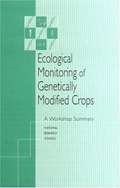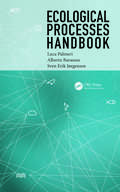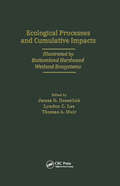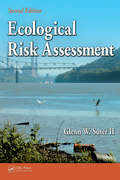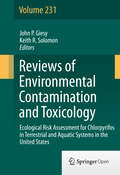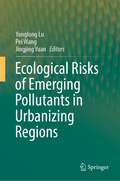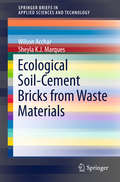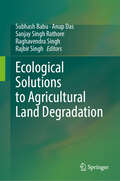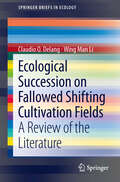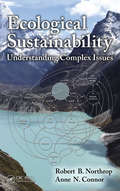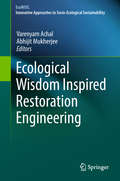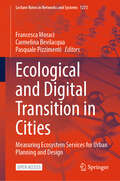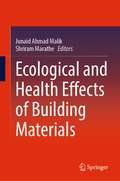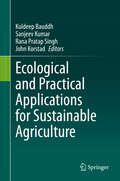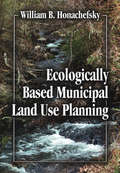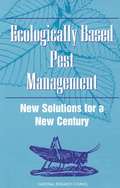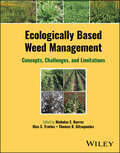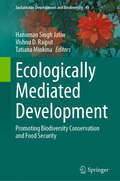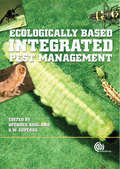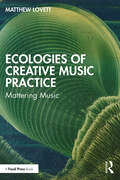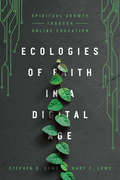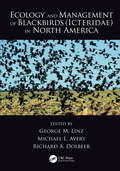- Table View
- List View
Ecological Modernisation and Renewable Energy
by David TokeDevelops a new theory of 'identity' ecological modernization (EM), to analyse renewable history and policy development in many of the world's states which are leading the drive to install renewable energy. 'Identity EM' concerns how an industry has arisen allied to environmental NGOs to challenge the ascendancy of conventional energy technologies.
Ecological Monitoring of Genetically Modified Crops: A Workshop Summary
by Robert PoolInformation on Ecological Monitoring of Genetically Modified Crops
Ecological Processes Handbook (Applied Ecology and Environmental Management)
by Sven Erik Jorgensen Luca Palmeri Alberto BarausseEcology is cross-disciplinary field involving many different aspects of science. Written with this in mind, this book introduces ecological processes, ranging from physical processes, to chemical processes and biological processes. It contains all the necessary information on an ecological process: a clear, detailed but not too lengthy definition,
Ecological Processes and Cumulative Impacts Illustrated by Bottomland Hardwood Wetland EcosystemsLewis Publishers, Inc.
by Coastal Ecology InstThis timely book is a "must-have" for anyone involved with wetland conservation, in particular bottomland hardwood forests, a habitat in which over 50% of our nation's inventory has been destroyed. Authored by recognized experts, the book thoroughly covers the ecological processes in bottomland hardwood forests and relates these processes to human activities. Chapters include original research into ecological processes, discuss impacts of human activities on flood plain ecosystems, and examine human perceptions of bottomland values and management strategies for ecosystem restoration and conservation. The book focuses on impact assessment and management, featuring local sites and ecosystems, as well as the processes in larger areas, such as watersheds and hydrological basins.
Ecological Risk Assessment
by Glenn W. Suter IIThe definitive reference in its field, Ecological Risk Assessment, Second Edition details the latest advances in science and practice. In the fourteen years since the publication of the best-selling first edition, ecological risk assessment (ERA) has moved from the margins into the spotlight. It is now commonly applied to the regulation of c
Ecological Risk Assessment for Chlorpyrifos in Terrestrial and Aquatic Systems in the United States
by John P. Giesy Keith R. SolomonReviews of Environmental Contamination and Toxicology attempts to provide concise, critical reviews of timely advances, philosophy and significant areas of accomplished or needed endeavor in the total field of xenobiotics, in any segment of the environment, as well as toxicological implications.
Ecological Risk Assessment: Innovative Field and Laboratory Studies
by Lawrence TannenbaumThis book is a compendium of highly purposeful studies all waiting to be conducted. It explains how avoiding common study design flaws, opportunities are created to observe that true risk assessment questions may not exist, that chemically exposed receptors are probably unharmed, and that ecological risk assessment might not be needed at all.
Ecological Risks of Emerging Pollutants in Urbanizing Regions
by Pei Wang Yonglong Lu Jingjing YuanThis book characterizes the major pollution patterns of emerging contaminants, such as sources, emission effluents, temporal and spatial distributions, multi-media transportation and transformation processes, exposure pathways to ecosystems and humans, and ecological risks. Based on this, it establishes an urbanizing region management concept and highlights how urbanization and its regional ecology have evolved into a more integrated vision. It also decouples the relations between urbanization and emissions of emerging pollutants that are framed within a broad socio-ecological context considering institutions, policies, and governance. All the theory, methods, and case studies have been taken from the authors’ publications, which have undergone rigorous international peer review. The book presents the spatial distribution, pathways, and flow diagrams of the pollutants as well as the interactions between urbanization and regional pollution and includes detailed figures and pictures. It also investigates ecological risk characterization and expression using maps based on geographic information systems to illustrate the general profile and the spatial variation of risks. The book is a valuable resource for postgraduates, researchers, academics, environmental NGOs, and regional managers such as urban planners, environmental agency staff, legal regulators, and decision makers. Bridging the gap between environmental science and policy, it offers interdisciplinary theory, approaches, and case studies that facilitate applications of frontier science in ecology and environmental science to regional social and economic development.
Ecological Soil-Cement Bricks from Waste Materials
by Wilson Acchar Sheyla K. J. MarquesThis book proposes the use of waste from oil drilling andsugar cane bagasse ash in the production of ecologically friendly soil-cementbricks. It offers a viable alternative to the traditional bricks available onthe market, which use wood as fuel: manufacturing bricks from waste is lesscostly and does not require the consumption of trees and forests. It alsoproposes an alternative to the current discharging of the above-mentioned typesof waste in sanitary landfills, avoiding additional environmental problems.
Ecological Solutions to Agricultural Land Degradation
by Anup Das Subhash Babu Rajbir Singh Raghavendra Singh Sanjay Singh RathoreThis book provides an overview of the current status of land degradation globally and the different approaches used for its restoration. In addition to the technical aspects, it also delves into the social and economic implications of land restoration, such as in terms of policy planning. Land degradation is a serious threat to agriculture, affecting soil function and productivity. There are up to 6 billion hectares of degraded soil worldwide. It is estimated that 30% of forests, 20% of agricultural land and 10% of rangelands are severely affected by land degradation. The main causes of land degradation are soil erosion, acidification, compaction and salinization, intensive agriculture, overgrazing, poor management of arable land and deforestation. The consequences of such degradation include sand dune expansion and displacement, reduced rainfall, rangeland depletion, wind and rain erosion, and loss of biomass and biological integrity. In 2015, the global goal of achieving land degradation neutrality (LDN) was included in the 2030 Agenda for Sustainable Development as sustainable development goal 15.3. Developing productive soil ecosystems by restoring degraded soils is therefore a future perspective for food security and environmental sustainability. This can be achieved through crop rotation, agroforestry, conservation agriculture, cover crops, terrace farming, ditching, geo-jute, and contour farming and zero tillage. Ecological restoration of farmlands offers an opportunity to reconcile agricultural production with improving ecosystem services. Restoring degraded land through environmentally friendly agroecological approaches has the potential to improve agricultural production and provide healthy ecosystems for organisms. This book is an important resource for students, academics, researchers, national and international agricultural scientists, and soil experts.
Ecological Succession on Fallowed Shifting Cultivation Fields
by Claudio O. Delang Wing Man LiThe book reviews the literature on the ecological succession of plants on fallowed swiddens in tropical forests. Patterns of ecological succession in tropical forests are insufficiently understood, partly because results are scattered through a large number of case studies reported in academic articles. So far, no publication has attempted to bring these different case studies together to identify common patters and trends. The goal of the book is to review the different case studies, and identify common patterns of ecological succession in fallowed swiddens, as well as to pinpoint the factors that cause ecological succession in some areas to differ from those in other areas. The book is organised in four different sections: forest structure, forest diversity, species composition, and the factors that contribute to differences in forest recovery rates (the number of times the field was burned, the length of fallow period, the type of soil, and the type of forest). This book is an important contribution to tropical forestry and shifting cultivation. Deforestation and forest degradation are the largest sources of CO2, and shifting cultivation is one of the main culprits. For this (and other economic and political) reason governments attempt to curtail shifting cultivation by shortening the years the fields can be left fallow, or outright outlawing the farming practice. Yet, there is insufficient understanding of the processes of ecological succession in fallows, which raises the questions as to whether the policy fulfils its objectives.
Ecological Sustainability: Understanding Complex Issues
by Robert B. Northrop Anne N. ConnorComplex systems is a new field of science studying how parts of a system give rise to the collective behaviors of the system, and how the system interacts with its environment. This book examines the complex systems involved in environmental sustainability, and examines the technologies involved to help mitigate human impacts, such as renewable ene
Ecological Wisdom Inspired Restoration Engineering (EcoWISE)
by Abhijit Mukherjee Varenyam AchalThis book focuses on ecological wisdom inspired restoration engineering through theories, hypotheses, policies, practical understanding, and case studies. Understanding nature’s processes is a prerequisite for the healthy and sustainable functioning of a habitable Earth. As such, the book provides a guide for readers seeking to understand and build sustainable, urban socio-ecological systems using restoration technologies based on wisdom. Motivated by recent rapid advances in restoration engineering, such as the role of green building materials in urban infrastructures, and developing sustainable landscapes to benefit the environment, economy and communities, it is an essential reference on the most promising innovative technologies. It discusses engineering methods and practices in the restoration of soil, water, heritage sites, and other ecosystems, as well as the development and applications of green building materials. It presents a holistic and systematic approach that utilizes natural resources and the concept of ecological wisdom to reap sustainable environmental, economic and social benefits to fulfill the concept of living in harmony with nature. This book is a valuable resource for civil- and environmental engineering researchers as well as organizations engaged in eco-restoration practices.
Ecological Wisdom: Theory and Practice (EcoWISE)
by Bo Yang Robert Fredrick YoungThis book offers an introduction to the theory and practice of ecological wisdom (EW). EW is the integration of robust contemporary science with proven cultural and historical practices to identify long-term, sustainable solutions to problems of environmental management and urban design. The book combines theoretical concepts with specific case studies, illustrating the opportunities for interdisciplinary approaches combining historical experience, cultural context, and contemporary science as effective strategies for addressing complex problems confronting metropolitan and rural environmental and resource management in areas such as land use, water management, materials and building engineering, urban planning, and architecture and design. EW transcends the limitations in these fields of the normative approaches of modernity or traditional wisdom by offering a new, synthetic strategy to address socio-ecological issues. By presenting these ideas both theoretically and through existing case studies, the book provides researchers, practitioners and students with a powerful new perspective in developing long-term, resilient solutions to existing socio-environmental challenges. It is intended mainly for those working or interested in the fields of sustainable environmental and resource management, city and regional planning, architecture and design, civil engineering, landscape architecture, and the philosophy of science, particularly those with an ecological or sustainability focus.
Ecological and Digital Transition in Cities: Measuring Ecosystem Services for Urban Planning and Design (Lecture Notes in Networks and Systems #1272)
by Carmelina Bevilacqua Francesca Moraci Pasquale PizzimentiThis open access book delves into the intersection of ecological, technological, and social dynamics at the core of urban transition and the relevance of urban planning and design in addressing the pressing challenges faced by cities and regions in the 21st century. This book is held at “Networks, Markets & People” Communities, Institutions and Enterprises toward post-humanism epistemologies and AI challenges, May 22–25, 2024, Reggio Calabria, Italy. The papers included in the book follow two main drivers. The first is dedicated to discussing the concept of ecosystem services exploring the role of policy and governance mechanisms in promoting the integration of ecosystem services into urban planning and design practices. The second presents various data-driven perspectives, methodologies, frameworks, and case studies for measuring ecosystem services in cities, ranging from traditional methods to cutting-edge digital mapping and modeling techniques. The book primarily targets academics, researchers, and students (undergraduate, postgraduates, Ph.D. students) providing interesting insights on the topic that can be useful for urban planning and design course in the urban studies, architecture, and engineering fields. It targets also policymakers, experts, professionals, and consultants active in the urban planning and design field involved in managing the transition of regions and cities
Ecological and Health Effects of Building Materials
by Junaid Ahmad Malik Shriram MaratheThis book deals with the present adverse effects of using precarious building materials on the ecology and human health. Also, the detailed discussions on the novel and greener construction materials and their utilization as an alternative to the conventional harmful existing methods and materials are also presented in the subsequent chapters. This book helps to fill the research gaps in the existing prior-art knowledge in the field of sustainable construction and green building materials and methods giving due importance to ecology and health, specifically to the fields of sustainable structural engineering, sustainable geotechnical engineering, sustainable road engineering, etc.This book helps in achieving a sustainable environment through possible adoption of innovative and ecological construction practices. Hence, this book acts as a practical workbook, mainly for the academicians and practicing engineers who are willing to work toward the consecrated building industry.It is a well-established fact that the constructions of the engineering structures consume more and more earth resources than any other human activities in the world. In addition, the construction-related activities will produce several million tons of greenhouse gases, toxic emissions, water pollutants, and solid wastes. This creates a huge impact on environment and causes severe health issues on humans and animals. It is thus important to create an eco-friendly construction environment which can satisfy the ecological and health requirements.
Ecological and Practical Applications for Sustainable Agriculture
by Rana Pratap Singh Kuldeep Bauddh Sanjeev Kumar John KorstadRampant industrialization, urbanization, and population growth have resulted in increased global environmental contamination. The productivity of agricultural soil is drastically deteriorated and requires a high dose of fertilizers to cultivate crops. To ensure food security, farmers are compelled to apply excess chemical fertilizers and insecticides that contaminate soil, air, and water. Heavy loads of chemical fertilizers not only degrade the quality of agricultural land but also pollute water and air. Use of chemical fertilizers also accelerate the release of greenhouse gases like nitrous oxide and methane along with nutrient runoff from the watershed in to lower elevation rivers and lakes, resulting in cultural eutrophication.Farming practices globally in developed, developing, and under-developing countries should utilize and promote sustainable methods through viable combined environmental, social, and economic means that improve rather than harm future generations. This can include use of non-synthetic fertilizers like compost, vermicompost, slow-release fertilizers, farmyard manures, crop rotations that include nitrogen-fixing legumes. Organic fertilizers like compost and vermicompost improve soil properties like texture, porosity, water-holding capacity, organic matter, as well as nutrient availability. The purpose of this book is to document the available alternatives of synthetic fertilizers, their mode of action, efficiency, preparation methodology, practical suggestions for sustainable practices, and needed research focus. The book will cover major disciplines like plant science, environmental science, agricultural science, agricultural biotechnology and microbiology, horticulture, soil science, atmospheric science, agro-forestry, agronomy, and ecology. This book is helpful for farmers, scientists, industrialists, research scholars, masters and graduate students, non-governmental organizations, financial advisers, and policy makers.
Ecologically Based Municipal Land Use Planning
by William B HonachefskyIn the decades following the first Earth Day in 1970, a generation has been enlightened about the unspeakable damage done to our planet. Federal, state, and local governments generated laws and regulations to control development and protect the environment. Local governments have developed environmental standards addressing their needs. The result-an ecologically incongruous pattern of land development known as urban sprawl.Local land use planners can have a greater effect on the quality of our environment than all of the federal and state regulators combined. Historically, they have existed on the periphery of land management. The author suggests that federal and state environmental regulators need to incorporate local governments into their environmental protection plans. Ecologically Based Municipal Land Use Planning provides easily understood, nuts and bolts solutions for controlling urban sprawl, emphasizing the integration of federal, state, and local land use plans.The book discusses ecological resources and provides practical solutions that municipal planners can implement immediately. It discusses the most recent scientific data, how to extract what is important, and how to apply it to the local land planning process. The author includes the application of the Geographic Information Systems (GIS) to problem solving.Despite compelling evidence and sound arguments favoring the implementation of an ecologically sensitive approach to land use planning, municipal planners, in general, remain skeptical. It will take considerably more encouragement and education to win them over completely. Ecologically Based Municipal Land Use Planning makes the case for sound land use policies that will reduce sprawl.
Ecologically Based Pest Management: New Solutions for a New Century
by Committee on Pest Pathogen Control through Management of Biological Control Agents Enhanced Cycles Natural ProcessesWidespread use of broad-spectrum chemical pesticides has revolutionized pest management. But there is growing concern about environmental contamination and human health risks--and continuing frustration over the ability of pests to develop resistance to pesticides. In Ecologically Based Pest Management, an expert committee advocates the sweeping adoption of ecologically based pest management (EBPM) that promotes both agricultural productivity and a balanced ecosystem. This volume offers a vision and strategies for creating a solid, comprehensive knowledge base to support a pest management system that incorporates ecosystem processes supplemented by a continuum of inputs--biological organisms, products, cultivars, and cultural controls. The result will be safe, profitable, and durable pest management strategies. The book evaluates the feasibility of EBPM and examines how best to move beyond optimal examples into the mainstream of agriculture. The committee stresses the need for information, identifies research priorities in the biological as well as socioeconomic realm, and suggests institutional structures for a multidisciplinary research effort. Ecologically Based Pest Management addresses risk assessment, risk management, and public oversight of EBPM. The volume also overviews the history of pest management--from the use of sulfur compounds in 1000 B.C. to the emergence of transgenic technology. Ecologically Based Pest Management will be vitally important to the agrichemical industry; policymakers, regulators, and scientists in agriculture and forestry; biologists, researchers, and environmental advocates; and interested growers.
Ecologically Based Weed Management: Concepts, Challenges, and Limitations
by Nicholas E. Korres Ilias S. Travlos Thomas K. GitsopoulosEcologically Based Weed Management Protect crop yields and strengthen ecosystems with this essential guide Research into weed management is an increasingly critical component of both environmental stewardship and food production. The potential cost of weed propagation can be measured in crop yield reductions, under-nourished populations, stymied economies, and more. The propagation of herbicide-resistant weed populations means that purely chemical weed management is no longer viable; food production can now be secured only with an ecological approach to weed control. Ecologically Based Weed Management details such approaches and their potential to manage weeds across a range of agricultural and environmental contexts. It emphasizes the deployment of ecological principles to prevent weed infestations, reduce crop losses, and strengthen ecosystems. In a time when growing population and changing climates are placing enormous pressure on global food production, this approach to weed management has never been more vital. Ecologically Based Weed Management readers will also find: A global team of expert contributors to a multidisciplinary approach Detailed discussion of topics like herbicide limitation, integrated weed management, and more Insights pertinent to agriculture, academia, government, industry, and more Ecologically Based Weed Management is ideal for researchers in agriculture chemistry, weed science, agronomy, ecology, and related fields, as well as for regulators and advanced students.
Ecologically Mediated Development: Promoting Biodiversity Conservation and Food Security (Sustainable Development and Biodiversity #41)
by Hanuman Singh Jatav Tatiana Minkina Vishnu D. RaiputThis edited volume addresses the critical need to balance biodiversity preservation with ensuring a nutritious and ample food supply for the growing global population. It emphasizes how conserving biodiversity enhances agricultural resilience, promotes sustainable food production, and safeguards food security for present and future generations. The book explores the complex interdependence between biodiversity and food security, identifying both challenges and threats, presenting solutions and strategies, and examining the roles of policies, governance, regulations, and international agreements. It highlights the importance of fostering research and raising awareness to promote sustainable agricultural practices, biodiversity conservation, and equitable resource access essential for long-term food security. The book includes real-world case studies and examples from different regions to demonstrate successful initiatives and the impact of biodiversity conservation on local food systems. This book provides a platform for researchers, conservationists, and policymakers to exchange knowledge and ideas on integrating biodiversity conservation into food security initiatives. It is a compilation of information by the experts and will be useful for researchers in the fields of botany, agriculture, nutrition, policy making and biotechnology.
Ecologically-based Integrated Pest Management
by Opender Koul Gerrit W. CuperusIntegrated pest management (IPM) is a sustainable approach to manage pests through biological, cultural, physical and chemical means in order to minimize economic and environmental injury caused by such pests. Any comprehensive IPM programme requires an understanding of the ecological relationships between crops, pests, natural enemies and the environment. This book presents a series of review chapters on ecologically-based IPM. Topics covered range from the ecological effects of chemical control practices to the ecology of predator-prey and parasitoid-host systems.
Ecologies of Creative Music Practice: Mattering Music
by Matthew LovettEcologies of Creative Music Practice: Mattering Music explores music as a dynamic practice embedded in contemporary ecological contexts, one that both responds to, and creates change within, the ecologies in which it is created and consumed. This highly interdisciplinary analysis includes theoretical and practical considerations – from blockchain technology and digital platform commerce to artificial intelligence and the future of work, to sustainability and political ecology – as well as contemporary philosophical paradigms, guiding its investigation through three main lenses: How can music work as a conceptual tool to interrogate and respond to our changing global environment? How have transformations in our digital environment affected how we produce, distribute and consume music? How does music relate to matters of political ecology and environmental change? Within this framework, music is positioned as a starting point from which to examine a range of contexts and environments, offering new perspectives on contemporary technological and ecological discourse. Ecologies of Creative Music Practice: Mattering Music is a valuable text for advanced undergraduates, postgraduates, researchers and practitioners concerned with producing, performing, sharing and listening to music.
Ecologies of Faith: Spiritual Growth through Online Education
by Stephen D. Lowe Mary E. LoweMany Christian institutions have embraced new technologies, especially online education. But is it possible for us to grow spiritually through our digital communities? Steve Lowe and Mary Lowe, longtime proponents of online education, trace the motif of spiritual growth through Scripture and consider how students and professors alike might foster digital ecologies in which spiritual transformation can take place.
Ecology and Management of Blackbirds (Icteridae) in North America
by George M. Linz Michael L. Avery Richard A. DolbeerShortlisted for the 2018 TWS Wildlife Publication Awards in the edited book category The various species of new world blackbirds, often intermingled in large foraging flocks and nighttime roosts, collectively number in the hundreds of millions and are a dominant component of the natural and agricultural avifauna in North America today. Because of their abundance, conspicuous flocking behavior, and feeding habits, these species have often been in conflict with human endeavors. The pioneering publications on blackbirds were by F. E. L. Beal in 1900 and A. A. Allen in 1914. These seminal treatises laid the foundation for more than 1,000 descriptive and experimental studies on the life histories of blackbirds as well as their ecology and management in relation to agricultural damage and other conflicts such as caused by large winter roosting congregations. The wealth of information generated in over a century of research is found in disparate outlets that include government reports, conference proceedings, peer-reviewed journals, monographs, and books. For the first time, Ecology and Management of Blackbirds (Icteridae) in North America summarizes and synthesizes this vast body of information on the biology and life histories of blackbirds and their conflicts with humans into a single volume for researchers, wildlife managers, agriculturists, disease biologists, ornithologists, policy makers, and the public. The book reviews the life histories of red-winged blackbirds, yellow-headed blackbirds, common grackles, and brown-headed cowbirds. It provides in-depth coverage of the functional roles of blackbirds in natural and agricultural ecosystems. In doing so, this authoritative reference promotes the development of improved science-based, integrated management strategies to address conflicts when resolutions are needed.

